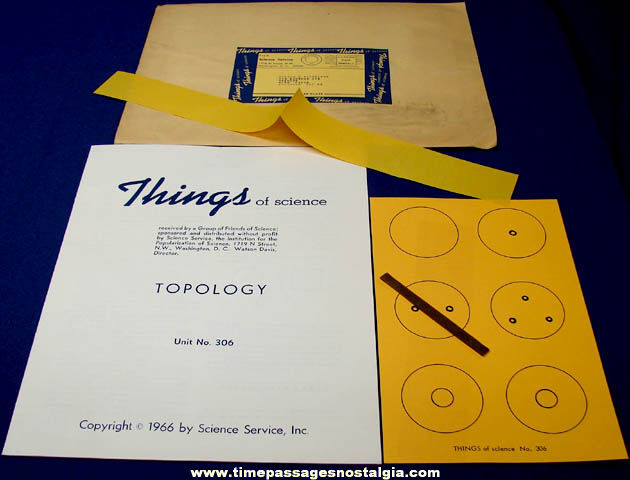
   | | | Any group of items being offered as a lot must be sold as a lot. | | | Unique & Fun Nostalgic Items | It's never too late to
have a happy childhood! | Whether you've collected Memorabilia for years or just want to feel like a kid again, please take a few moments to browse through what we
have available for sale. | Great memories
make great gifts! | | An Ever Changing Inventory | | We have an extensive inventory that is not yet on our web site. If there is something you are looking for and did not find, please send us your wish list. | Quality Packing And
Postal Insurance | Don't forget to
bookmark this site. |
| | | | The picture shows a view of this ©1966 #306 Topology Science Service Things of Science Kit with all of its contents. These kits have items pertaining to their subject matter to conduct experiments or tests as outlined in the booklet that is included. Because many of these kits contain chemicals or other possibly harmful items if misused, please read the following: This item or lot is being offered as an old collectible Scientific item. It is not intended nor being sold for consumption or misuse. By buying this item you agree to take full responsibility for all of the contents. You agree that you will not hold Time Passages Nostalgia Company liable or responsible for any injury or illness that may result from anyone mistakenly eating or misusing any of its contents in any way now or any time in the future. This #306 Topology Things of Science Unit (kit) contains the following items: INSTRUCTION BOOKLET WITH PROJECTS
A 1-1/4'' x 15'' STRIP OF PAPER
RUBBER BAND
A 5'' x 8'' CARDBOARD WITH CIRCULAR FIGURES
MAILER ENVELOPE COVER This kit was mailed from the Science Service in Washington, D.C. to a Melrose, Massachusetts address. To judge the sizes the instruction booklet measures 8-1/2'' x 10-7/8''. The mailing envelope has some light wear from mailing but the contents appear to be complete and in mint condition as pictured. For reference, below here is some background information on these ''Things of Science'' units or kits: Rediscovering Things of Science
by George B. Moody For many years, the Science Service produced a monthly series of science kits called ''Things of Science'', available by subscription. When I was a kid (in the 60s), I subscribed to Things of Science for several years. I suspect that many of us who chose careers in the sciences found at least part of our inspiration in those blue boxes that arrived in the mail every month (well, almost every month; sometimes we'd get manila envelopes, filled with stuff that wouldn't fit in the boxes). Each kit (''unit'') had a booklet of experiments, and usually everything needed to perform them. History The original mission of the Science Service, a nonprofit organization founded in 1921 by newspaper publisher E. W. Scripps (1854 - 1926) and still active today as publishers of Science News, was to educate the public about science, principally as a news service, by providing articles describing current research to newspapers and popular magazines. The Things of Science program, which was launched in November 1940, was the brainchild of Watson Davis (1896 - 1967), director of the Science Service from 1928 until 1967. Interviewed in a 1946 Wall Street Journal article, Davis traced the beginnings of Things of Science to samples of new materials sent out with Science Service news stories as an attention-getter. ''It was Davis who dreamed up the little packages that make every man a museum head who wants to be. The first ones were sent to newspaper editors to help sell natural science stories,'' wrote Herbert Nichols, science editor of the Christian Science Monitor, in a 1952 article about Things of Science. Early in the program's history, the emphasis shifted to young people. Already in 1946, the Science Service estimated that half of its subscribers were school groups and science clubs, and the other half individuals. Things of Science brought journalists, teachers, and students alike in direct contact with not only the ideas but also samples of the actual stuff (unusual and often new materials) that researchers were inventing or studying. The early boxes were light brown. The first of the familiar blue boxes appeared between October 1943 and September 1944. The wartime units provide intimate and often startling perspectives on their period. The samples in the Unusual Fabrics Unit of September 1942 were described as materials ''of special value now because of war shortages and of promise for the days after the war when industrial progress will usher in many new products;'' how must it have felt to handle and study these swatches of otherwise unattainable luxuries? A year later, the Cork Products Unit recruited subscribers to a grand project to survey the United States for wild cork oaks, since the supply of Spanish cork was uncertain during World War II and finding a native supply was a priority. Since the program relied on donated materials, the Science Service limited the number of subscriptions, initially to 1,000, but increasing to 5,000 (with a waiting list) in 1944, 7,000 in 1946, and 12,000 in 1952. In 1957, support for the program allowed the Science Service to expand the number of subscribers again, as noted in a flyer about the program. The blue boxes I remember from the 60s were full of things to study, things to build, and experiments to try. Some boxes contained things I had seen before, but never really noticed. Others contained things I had never seen (a polypropylene hinge, made of a single piece of plastic, that could flex hundreds of thousands of times without breaking; a silkworm's cocoon, the size of a jelly bean, made of a strand of silk a kilometer long; a diffraction grating; copper ore; polarizers; flexible magnets). Subscriptions were cheap even by the standards of the time, which was a good thing since I had very little money to spend. I remember saving up a quarter every week for four months to get my subscription. The Science Service produced and distributed Things of Science for about 40 years, through 1980. In 1981, the Science Service transferred its rights in the program to an independent company that produced additional units until at least 1989. The owner during at least part of this period was Andrew E. Svenson, Jr. (1939 - 2005), whose father was a noted author of children's books. The Science Service has reacquired rights to Things of Science and may revive the program at some time in the future. The archives of the Smithsonian Institution contain a large collection of Science Service records. Designated Record Unit 7091, this collection is indexed in a finding aid. (Among its treasures is a collection of photographs taken by Watson Davis at the famous Scopes ''monkey trial'' in 1925.) I have not had an opportunity to examine the collection, but the finding aid suggests that at least 10 of the 457 boxes of records contain historical material relating to the Things of Science program. For example, one of these boxes is recorded as containing: Box 306, folder 10: England - Science News Letter, ''THINGS of Science,'' and Science Talent Search, 1948. Efforts to duplicate Science Service activities in England. As noted below, an independent UK-based Things of Science program appeared during the mid-1960s. On 10 January 2008, the Science Service became the Society for Science and the Public. About the units First, some general information I've been able to glean from looking at many units. The first 338 units (created between 1940 and 1968) were consecutively numbered, although the numbers did not appear in the first 20 (possibly as many as 22) units. An extra unit, numbered 25A (Nylon Monofilament Unit), was issued together with unit 25 (Resin Bonded Plywood Unit), and subscribers apparently received both units together in one envelope. Units issued in 1969 and later years were not numbered, and it can sometimes be difficult to establish even the year of their production. The mailing labels on most units indicate the expiration date of the subscriber's subscription, and not the date when the unit was produced or mailed. Both the 1 year and 2 year subscriptions were offered at various times, so it is reasonable to assume that the production date of an unknown unit was at some time during the two years prior to the mailing label date. The copyright date on the booklet indicates the year (and in some cases, the month) of production. The units were usually received by subscribers during the month following the production date, but sometimes much later (since it was possible to order extra units when available). The dates for the unnumbered units have been discovered from a variety of clues, but there is some uncertainty about them and most of the unnumbered units are only dated by year. Certain topics, such as aerodynamics, chemical models, computation, crystallization, fossils, geometric models, optical illusions, probability, and surface tension, appeared on multiple occasions. A new collection of seeds was something to anticipate in February most years. Typically, the booklets were revised and new experiments were added whenever a title reappeared. Things of Science in the UK During the late 1960s, Geoffrey Young ran a UK-based ''Things of Science'' program for ACE (the Advisory Centre for Education, based at that time in Cambridge), which produced a series of at least 16 kits in 1966. Tien Bryan sent me a photo of nine of these kits from 1966, which came in boxes with imprinted titles and numbers. It appears that at least 12 of these kits were reissued between 1966 and 1968. My own collection includes 11 kits dated 1966, 1967, and 1968, which came in boxes with imprinted numbers only. Since the numbers do not appear on the instruction sheets or elsewhere in the kits, their association with the kits is uncertain, and I suspect that the boxes on my kits may have been shuffled long ago; in particular, based on the dates, it seems likely that the Chemical Indicators kit currently housed in box 2 may have originally been supplied in the missing box 11. Although several of the titles and some of the materials also appear in the Science Service's Things of Science, the accompanying experiments are different, and it appears that instruction sheets included in the ACE Things of Science were written specifically for those kits. Thanks to George B. Moody for providing the History Above. |
|
Click on image to zoom.
 |